The Unified Team's second place finish in Group B saw them matched up against Finland, who finished third in Group A, on February 18th. The Unified Team won easily by a score of 6-1 to advance to the semifinals against the United States, who they easily dispatched 5-2 to earn a place in the gold medal game on this date in 1992.
Tuesday, February 23, 2016
1992 Unified Team Andrei Kovalenko Jersey
The world outside of hockey was in a time of upheaval as the 1992 Winter Olympic Games in Albertville, France were approaching.
The Unified Team's second place finish in Group B saw them matched up against Finland, who finished third in Group A, on February 18th. The Unified Team won easily by a score of 6-1 to advance to the semifinals against the United States, who they easily dispatched 5-2 to earn a place in the gold medal game on this date in 1992.
Soviet Union leader Mikhail Gorbachev had ushered in a new era of reforms. The Central Committee of the Communist Party agreed to give up it's monopoly of power in February of 1990 and several Soviet Republics had declared their independence, with Lithuania and Estonia doing so in March of 1990 and Latvia following in May.
In March of 1991 a referendum vote was held and 76.4% was cast in favor of retaining the Soviet Union, but with a level of reforms. Seven republics boycotted the vote however, so the results were far from being as decisive as they sounded. In June of 1991, Boris Yeltsin won the post of President of Russia and took office on July 10, while Gorbachev still led the Soviet Union.
Yeltsin and Gorbachev
Yeltsin's policies favored the the dissolution of the Soviet Union, while Gorbachev attempted to restructure the Soviet Union as still a single entity. The New Union Treaty was set to be signed on August 20, 1991 which would convert the Soviet Union to a federation of independent republics with a common president and military force.
On August 19, 1991, hardliners looking to preserve the Soviet Union, and their own personal power in the process, put Gorbachev under house arrest and attempted to revoke his reforms which had granted unprecedented freedoms. They issued an emergency decree, suspended political activity and shut down most of the newspapers. Yeltsin quickly condemned their actions and the coup organizers attempted to have him arrested but failed.
Three days later the coup failed, it's organizers were arrested and Gorbachev returned to power as president of the Soviet Union, but with his powers now compromised.
On December 1, 1991, 90% of the voters in Ukraine voted for independence from the Soviet Union. Then a week later the leaders of Russia, Ukraine and Belarus met to discuss how to proceed and signed an agreement to dissolve the Soviet Union and replace it with the Commonwealth of Independent States (CIS), which Gorbachev described as an unconstitutional coup.
On December 12th, Russia ratified the Belavezha Accords and on December 21, 1991 representatives of all the member republics of the Soviet Union signed the Alma-Ata Protocol, confirming the dissolution of the Soviet Union. The same day, all of the former Soviet republics agreed to join the CIS with the exception of Georgia and the three Baltic States, Lithuania, Estonia and Latvia.
Gorbachev resigned on December 25th and transferred any remaining powers of his office to Yeltsin and the Soviet hammer and sickle flag was lowered for the final time over the Kremlin on December 26th. By December 31, 1991, all official Soviet government operations had ceased and the individual republics assumed governmental control.
This greatly affected their World Junior Hockey Team, as they had left for Germany as the Soviet Union, which ceased to exist midway through the tournament. They eventually won the gold medal only to return home to find their country no longer existed!
The Olympics began on February 8, 1992 in Albertville, France with a joint team consisting of players from six of the former 15 Soviet republics, Russia, Ukraine, Kazakhstan, Belarus, Uzbekistan and Armenia competing as the Unified Team under the Olympic flag.
The Unified Team was placed in Group B and completed their schedule with a 4-1 record with dominant wins over Switzerland, Norway, France and a one goal victory over Canada and their only loss coming to Czechoslovakia, who would also cease to exist as a nation at the end of the year when it divided into the Czech Republic an Slovakia.
The Unified Team battles Czechoslovakia
The Unified Team's second place finish in Group B saw them matched up against Finland, who finished third in Group A, on February 18th. The Unified Team won easily by a score of 6-1 to advance to the semifinals against the United States, who they easily dispatched 5-2 to earn a place in the gold medal game on this date in 1992.
There was no score after the first period of play, despite the first power play for Canada and three subsequent ones for the Unified Team, including a brief 5-on-3 for 12 seconds. The shots on goal were tied at 10-10 after one.
The game continued on and the tension grew as the second period also passed with no scoring. The Unified Team had the only power play of the period, but failed to convert. The Unified Team clearly carried the play in the second period, outshooting the Canadians 15-6.
Finally one minute and one second into the third period, Vyacheslav Butsayev solved Canadian goaltender Sean Burke with an assist from Evgeny Davidov. The game remained close for the next 14 minutes until Igor Boldin added to the Unified Team's lead when he scored from Nikolai Borschevsky and Vitali Prokhorov at 15:54, leaving the Canadians just four minutes to do what they had failed to do in the previous 56, score on goaltender Mikhail Shtalenkov.
1:26 later they did just that, giving them hope that a comeback was in progress when Chris Lindberg scored with assists from Joe Juneau and Jason Woolley to reduce the Unified Team's lead back to one.
Vyacheslav Bykov sealed the gold for the Unified Team with their third goal of the period with just 1:09 remaining from Andrei Khomutov. to make the final score 3-1.
Surprisingly, none of the four goals in the period came on the power play despite two penalties for Canada and four for the Unified Team, which included 25 seconds of 5-on-3 midway through the period and 59 seconds more beginning at the 13:06 mark which Canada failed to convert. Despite the edge in powerplay time, the Canadians were outshot 12-6 in the third period for a final edge of 37-22 for the Unified Team, which consisted of 19 Russians, 2 Ukrainians, a Belorussian and a Lithuanian.
By the time the next Winter Olympics game just two years later, in an effort to separate them from the Summer Olympics, the political situation in the former Soviet Union had a chance to stabilize, as did the world of hockey, which saw the creation of many new national teams, including those of Lithuania, Latvia, Estonia, Belarus, Ukraine and Kazakhstan which were all former republics of the Soviet Union, but now had their own national teams competing in international hockey, as well as the additions of Slovakia, Croatia and Slovenia, which were created as a result of the divisions of Czechoslovakia and Yugoslavia.
Russia, now fielding it's own team in 1994, placed fourth and out of the medals for the first time since they joined the Olympics as the Soviet Union in 1956.
Today's featured jersey is a 1992 Unified Team Andrei Kovalenko jersey as used in the 1992 Winter Olympics in Albertville, France. With the upheaval of the political situation in the Soviet Union in 1991, there was little time to sort out what kind of identity the brand new team made up of six of the 15 former Soviet republics would compete with. Mind you, the Unified Team was not the Commonwealth of Independent States (CIS) Team, which was comprised 12 of the 15 Soviet republics and acted more like an association comparable to the European Union, rather than a country, such as the Soviet Union had been.
The Unified Team competed under the Olympic flag, and with just five weeks before the games were to commence, the jersey supplier to all the Olympic teams, Tackla of Finland, made up a set of the usual Soviet Union jerseys, only without the "CCCP" lettering across the chest. Note that they did not even continue across the chest or even alter the remaining stripes, which were still notched on the left hand side for the curvature of the "P"!
This was the one and only appearance for these stop-gap jerseys, as Russia competed in a new set of jerseys at the 1992 World Championships held just two months later in April as an independent nation, separate from the other five countries of the Unified Team.
Bonus jersey: Today's bonus jersey is a 1992 Unified Team Alexander Andrievsky jersey. This road red jersey was prepared for Andrievsky, who did not make the final roster for the Unified Team in 1992.
Note the difference in the red jerseys compared to the white set, as the inner ends of the white and yellow chest stripe on the player's left side both end in a vertical alignment, unlike the white jersey's chest stripes which still retain the curvature of the absent "P" from the former CCCP cresting.
Today's video selection is the gold medal game from the 1992 Olympics, as the Unified Team, wearing their jerseys without any national identity, captures the gold medal against Canada.
This next clip begins with the Unified Team's Group B game against Czechoslovakia and is of superior video quality compared to the previous clip of the gold medal game. It turned out to be their only loss of the tournament. The video continues with the Czechs playing against Sweden, Canada and finally the United States in the bronze medal game.
For those with the time, here is the complete game between the Unified Team and the United States from the 1992 Olympics.
Labels:
Kovalenko Andrei,
Russia,
Soviet Union,
Unified Team
Subscribe to:
Post Comments (Atom)

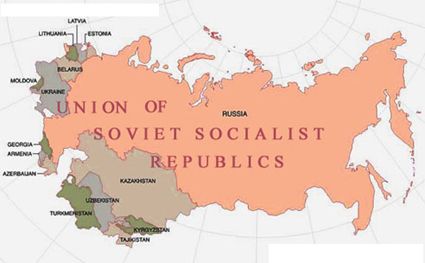
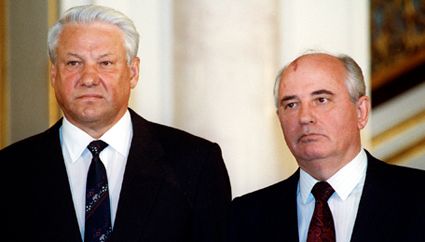
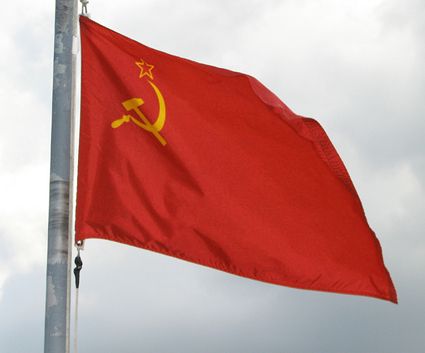
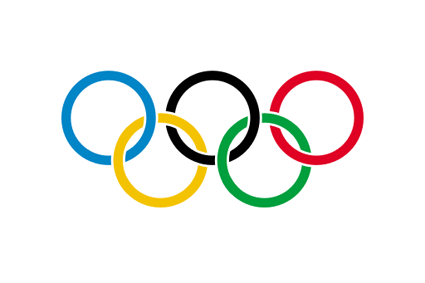
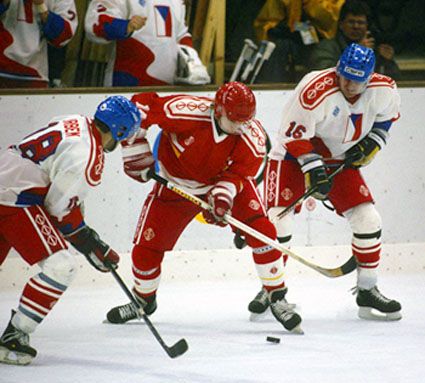

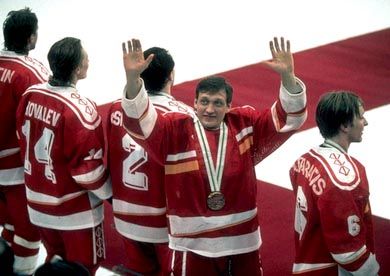
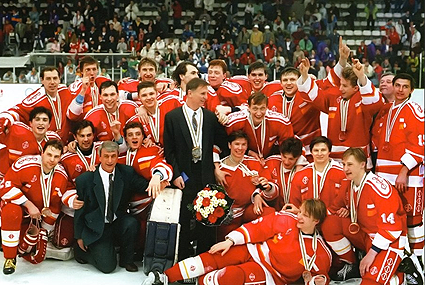
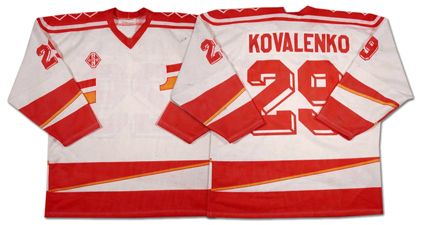

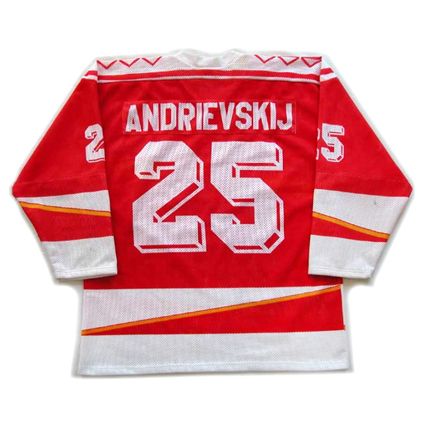










No comments:
Post a Comment
We welcome and encourage genuine comments and corrections from our readers. Please no spam. It will not be approved and never seen.